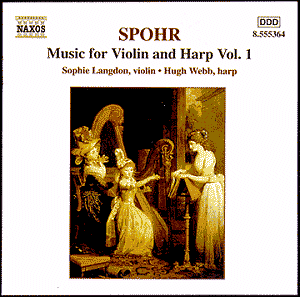Louis SPOHR (1784-1859)
Sonata Concertante for Violin and Harp in D Major, Op. 115 |
Allegro brillante
Adagio
Rondo: (Allegretto)
Sonata for Violin and Harp in C Minor
Adagio-Allegro vivace
Andante-Allegro
Trio for Violin, Cello and Harp in E Minor (1806)
Allegro
Andante con moto
Rondo: (Allegretto)
Sonata for Violin and Harp in B flat Major, Op. 16
Allegro
Adagio
Rondo (Allegretto)
 Sophie Langdon (violin), Hugh
Webb (harp), Louis Dorey (cello) Sophie Langdon (violin), Hugh
Webb (harp), Louis Dorey (cello)
Rec: St Martin's Church, East Woodhay, East Sussex, 1998
 NAXOS 8.555364 [76.57] NAXOS 8.555364 [76.57] |
 |
| Crotchet
AmazonUK
AmazonUS
Amazon
recommendations |
Louis Spohr was born in North Germany and showed great talent for
the violin from an early age, joining a ducal orchestra when fifteen. Supported
by the Duke, he undertook tours when only 20 and won overnight fame when
he played at a Leipzig concert. His career began when he became leader of
a Vienna theatre orchestra and, later, opera director at Frankfurt and Kassel.
He undertook many international virtuoso concert tours and conducted at numerous
music festivals. Spohr was impressed by Mozart as a composer and was a friend
of Beethoven. I'll leave it to the listener to judge whether these influences
have rubbed off on Spohr's compositions. (One will be aware of the richness
of harmony and command of modulation and chromaticism.) He wrote a number
of duos for violin and harp, played by himself on violin and accompanied
by his wife on the harp.
In writing for the harp and violin one technical obstacle had to be overcome:
if the violin was to sound its best it meant writing in keys which were the
worst possible for the harp, where the higher tension could lead to string
breakages. To overcome this difficulty, the harp would be tuned a semitone
lower than concert pitch and the part written in a flat key. In flat keys
fewer pedals would then be needed.
In the Sonata Concertante for Violin and Harp in D Major we find Spohr's
composition treats both instruments with equal importance. The Adagio is
quite haunting and illustrates exactly why Paganini referred to Spohr as
'the most outstanding singer of the violin'.
The Sonata for Violin and Harp in C Minor is stylistically a mixture
between Haydn and Mozart. This is an early composition involving a harp part.
Both this and the previous work contain attractive melodies and are ideal
for a chamber setting. But the compositions are thin and could have benefited
from the added colour provided by additional instrumental parts.
The Trio for Violin, Cello and Harp in E Minor which follows is a
lovely chamber piece, the cello providing a new-found depth to the composition.
Yet he was critical about the work and disappointed with the result.
The Sonata for Violin and Harp in B flat Major written shortly after
his marriage is a bright work with the violin taking a discreet presence
with an emphasis on lyricism and sustained notes while the harp provides
a virtuoso display of glittering runs. The Rondo finale contains a catchy
toccata-like moto perpetuo for the harp.
The soloists have much experience behind them and display considerable skill
and maintain good team spirit. The recording is clear and the recording venue
suits the characteristics of the instruments.
This is not a disc one would wish to repeatedly play but it does provide
a diversion from the music normally listened to.
Raymond Walker

